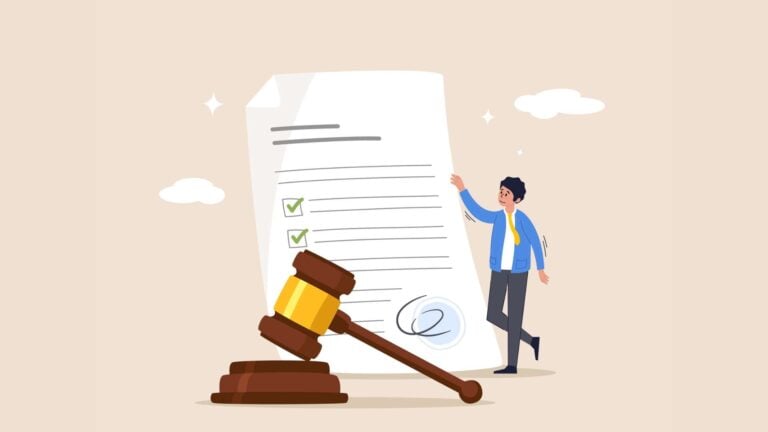At-will employment is the most common standard for employment relationships in the US, but it’s subject to many exceptions that can make it tricky to understand. This article explains what at-will means and how employers should approach hiring at-will employees.
At-will employment is the basis for most employment relationships in the United States. It’s a key part of the country’s labor law, and understanding all aspects of it is crucial to keeping your business compliant and avoiding costly legal troubles.
But that’s often easier said than done. It can be challenging to know what at-will employment really is, what exceptions exist across the country, and what exceptions apply only in specific states.
That’s why we’re here to help. This article outlines the benefits and challenges of at-will employment, exceptions on the federal and state labor law levels, and more.
What Is At-Will Employment?
At-will employment is a legal doctrine that allows employers to terminate employees anytime, for any reason or no reason, as long as the termination doesn’t violate a law or contract. This is different from terminating an employee “for cause,” which means the termination was for a clearly stated reason related to the employee’s performance.
Similarly, at-will employees can quit their jobs at any time, for any reason, without providing notice.
Under at-will employment, no employment contract is required. Employers also don’t need their employees to sign an agreement that the employment relationship is at will for the doctrine to apply.
At-Will Employment Benefits
Most jobs in the US function under at-will employment, and this relationship offers benefits for both employers and employees. These include:
More flexibility
Under at-will employment, employers can make staffing decisions quickly, often with a shorter recruitment process.
Employers also don’t need to worry as much if a new employee can’t do the job as expected because at-will employment means ending their employment is easier.
Meanwhile, at-will employees can seek new opportunities without lengthy notice periods if their role is a poor fit.
Less complex terminations
Unlike contractual employment relationships, at-will employment allows for a simplified termination process. Employers can act on their termination decisions quickly—and with significantly less legal risk. Employees are also under no legal obligation to provide an explanation or take formal steps before moving on to a new opportunity.
Competitive job markets
Without long notice periods or restrictions on taking on new employment, at-will workers can move freely and quickly. This fosters competition among employers to attract the best talent—which can benefit employees seeking better compensation, benefits, and career growth opportunities.
At-will employees can also benefit from employers’ efforts to retain them, such as by fostering a positive work environment and prioritizing work-life balance.
At-Will Employment Challenges
While at-will employment has its advantages, it also comes with some difficulties. Employees tend to feel challenges more than employers, although employers can face troubles, too.
Common challenges include:
Job insecurity
Under at-will employment, employees may feel insecure in their positions due to the possibility of abrupt termination, leading to decreased job satisfaction.
📚This Might Interest You
Read Connecteam’s guide on measuring employee satisfaction, which includes 6 tips on improving it at your workplace.
This can be damaging for both employees and employers, who may face higher turnover from employees who leave the company for more security elsewhere.
Limited legal protection
Without an employment contract, employees terminated without cause may find it challenging to pursue legal action unless they can prove discrimination.
The challenge of limited legal protection can extend to employers, who might find it time-consuming and costly to resolve legal disputes about an employee’s termination.
Short-term focus
The uncertainty associated with at-will employment can sometimes lead employees to prioritize short-term job stability over long-term career growth. They may be less willing to take risks, innovate, or invest in their skills if they fear sudden job loss.
📚This Might Interest You
Discover how to create a career path for your employees and retain top performers in 2025.
When Should You Not Choose At-Will Employment?
Many employers choose to avoid at-will employment and enter into employment contracts instead. Below are 2 common situations where not choosing at-will employment may make sense for you.
- When you have many high-level employees. For instance, you might want to enter into an employment contract with your C-level executive employees. High-level employees often impact long-term goals and strategies for the organization, and choosing a contract relationship instead of at-will builds more structure around how and when they can leave. This employment relationship can help ensure your top strategic employees stay focused on business goals instead of worrying about job stability or being easily tempted by a competitor’s offer.
- When you have roles requiring specialized skills. You might choose to avoid an at-will employment relationship with employees in specialized roles to ensure your company benefits from their expertise for longer.
Federal Exceptions to At-Will Employment
Federal laws introduce exceptions to at-will employment by making it illegal to terminate an employee for discriminatory or retaliatory reasons, no matter which state your business operates in. Let’s take a closer look at these exceptions.
Termination for discriminatory reasons
Employers cannot terminate employees based on their protected characteristics. This means that the reason you choose to fire an employee cannot be due to their:
- Race.
- Sex (or their gender, sexual orientation, or pregnancy).
- Religion.
- Age.
- Disability.
- National origin.
- Genetic information.
This exception is covered under various federal anti-discrimination laws.
Termination for retaliatory reasons
It’s illegal under several federal laws to fire an employee in retaliation.
Retaliation occurs when an employee reports discrimination or takes action to oppose discrimination, and their employer punishes them as a result. Examples of opposing discrimination would be participating in a workplace investigation or speaking up to protect a coworker from discrimination.
🧠Did You Know?
According to the Equal Employment Opportunity Commission (EEOC), retaliation is “the most frequently alleged basis of discrimination.”
State Exceptions to At-Will Employment
Almost all states allow at-will employment throughout the employment relationship.
The one exception is Montana, where an employee can only be fired for cause after completing a 12-month probation period. Termination for cause means the employer had a valid reason, such as misconduct, for terminating employment. During the probation period, at-will employment rules still apply in Montana.
All other states allow at-will employment continuously. However, some at-will states recognize and make exceptions when rules don’t apply in certain situations. Each state that has adopted exceptions falls into one or more of these categories:
Public policy
Public policy is the most common exception, adopted by 42 states.
Under this exception, an employee cannot be terminated for exercising a legal right or refusing to do something illegal.
For example, consider an employee who’s injured at work and files a workers’ compensation claim. Firing that employee for filing the worker’s compensation claim would violate the public policy exception to at-will employment.
Another example would be an employee who refuses to cover up a supervisor’s sexual harassment of a coworker. Firing them for that refusal also violates the public policy exception.
Implied contract
The second most common exception, adopted by 37 states, is the exception for implied contracts.
When employment is subject to specific rules, it can create an implied employment contract. Under at-will employment rules, employment cannot be terminated once an implied contract has been made.
For instance, say you adopt a policy that states employees will only be terminated for a reason. You must follow this rule even though it isn’t outlined in a formal employment contract.
Employers often unintentionally create an implied contract when they develop employee discipline policies that state employees must receive a certain number of disciplinary actions before they can be terminated.
Good faith and fair dealing
Last is the good faith and fair dealing exception, present in only 11 states.
States that have adopted this exception require employers to provide a termination reason that is lawful, fair, and reasonable. This is also called an implied covenant of good faith and fair dealing. You can think of it as a promise to treat employees fairly and without deceit.
A termination that would violate this exception would be firing employees to avoid paying their retirement benefits.
At-Will Exceptions by State
So, how does your state interpret the at-will employment relationship? What are the state-level exceptions to employment at will?
We’ve created a table outlining at-will employment states and the exceptions each state (and the District of Columbia) has adopted.
As a reminder, Montana’s exceptions apply only during the employee’s 12-month probation period.
| State | Public Policy Exception | Good Faith and Fair Dealing Exception | Implied Contract Exception |
| Alabama | X | ✔ | ✔ |
| Alaska | ✔ | ✔ | ✔ |
| Arizona | ✔ | ✔ | ✔ |
| Arkansas | ✔ | X | ✔ |
| California | ✔ | ✔ | ✔ |
| Colorado | ✔ | X | ✔ |
| Connecticut | ✔ | X | ✔ |
| Delaware | ✔ | ✔ | X |
| District of Columbia | ✔ | X | ✔ |
| Florida | X | X | X |
| Georgia | X | X | X |
| Hawaii | ✔ | X | ✔ |
| Idaho | ✔ | ✔ | ✔ |
| Illinois | ✔ | X | ✔ |
| Indiana | ✔ | X | X |
| Iowa | ✔ | X | ✔ |
| Kansas | ✔ | X | ✔ |
| Kentucky | ✔ | X | ✔ |
| Louisiana | X | X | X |
| Maine | X | X | ✔ |
| Maryland | ✔ | X | ✔ |
| Massachusetts | ✔ | ✔ | X |
| Michigan | ✔ | X | ✔ |
| Minnesota | ✔ | X | ✔ |
| Mississippi | ✔ | X | ✔ |
| Missouri | ✔ | X | X |
| Montana *during probation period only* | ✔ | ✔ | X |
| Nebraska | X | X | ✔ |
| Nevada | ✔ | ✔ | ✔ |
| New Hampshire | ✔ | X | ✔ |
| New Jersey | ✔ | X | ✔ |
| New Mexico | ✔ | X | ✔ |
| New York | X | X | ✔ |
| North Carolina | ✔ | X | X |
| North Dakota | ✔ | X | ✔ |
| Ohio | ✔ | X | ✔ |
| Oklahoma | ✔ | X | ✔ |
| Oregon | ✔ | X | ✔ |
| Pennsylvania | ✔ | X | X |
| Rhode Island | X | X | X |
| South Carolina | ✔ | X | ✔ |
| South Dakota | ✔ | X | ✔ |
| Tennessee | ✔ | X | ✔ |
| Texas | ✔ | X | X |
| Utah | ✔ | ✔ | ✔ |
| Vermont | ✔ | X | ✔ |
| Virginia | ✔ | X | X |
| Washington | ✔ | X | ✔ |
| West Virginia | ✔ | X | ✔ |
| Wisconsin | ✔ | X | ✔ |
| Wyoming | ✔ | ✔ | ✔ |
How Employers Should Approach At-Will Employment
Here are some best practices to follow when navigating at-will employment in your business:
Know your local rules
It’s a mistake to assume the same rules apply to employees across the US. Carefully review at-will exceptions at the federal level and in your state—especially if you have many at-will employees.
Be aware of how your actions can change the at-will relationship
Avoid taking actions that could create a greater administrative burden or increase legal risk.
For example, avoid adopting employment policies that could create an implied employment contract.
Also, be aware of how a termination may be perceived. For example, imagine an employee has recently engaged in a protected activity, such as reporting harassment or discrimination in the workplace. Terminating that employee without reason may leave room for them to claim the reason was retaliation for their actions. This can lead to legal issues you might have avoided by stating a clear legal reason for the termination.
Adopt clear communication strategies
While you aren’t required to provide a reason for terminating an at-will employee, you’re much less likely to face legal challenges if the termination decision isn’t a surprise.
Conducting employee performance reviews can help create effective communication with an employee who isn’t meeting your expectations. You can also use performance reviews to explain what will happen if their performance doesn’t improve—e.g., termination.
📚 This Might Interest You:
We put together a guide of the best employee evaluation software of 2025
That said, effective communication can help prevent you from needing to terminate at-will employees in the first place.
Ensure you stay in touch with your employees and hold regular check-ins to share updates on their performance and offer support. Also, consider implementing an open-door policy where workers can express concerns and ask questions as they arise.
These strategies help create an environment where employees have the opportunity to improve their performance and avoid being fired.
🧠Did You Know?
Connecteam is the perfect solution for all your employee management needs. It offers secure document management, intuitive onboarding and training tools, an in-app chat for seamless communication, customizable surveys and polls, more. It makes managing all your employees—at-will or otherwise—quick and easy.
FAQs
Can an at-will employee collect unemployment after being terminated?
Most states don’t allow workers to collect unemployment if they’re at fault for being out of work. For example, an employee fired for poor performance typically can’t receive unemployment benefits.
As an employer, you aren’t required to provide a reason for terminating an at-will employee. However, if you choose not to give a reason for the termination, the state may decide the worker isn’t to blame for being unemployed.
Are union employees at-will?
Employees represented by a union are subject to the terms of the collective bargaining agreement between the union and the employer. Usually, union contracts require that employment can only end for cause.
If you have union employees in your business, review your union contract for rules governing employee discipline and termination.
What rights do at-will employees have?
While at-will employment is most often discussed in terms of when and how an employer can terminate the employment relationship, it also offers some rights for employees.
The main right at-will employees have is to quit their jobs immediately and without an explanation. In contrast, employees subject to an employment contract usually have a required notice period—usually 2 weeks—they must give before leaving their jobs.
At-will employees don’t give up other employment rights protected by law. For example, they still have the right to work without illegal discrimination or harassment. Employment at will also doesn’t change compliance with other employment laws.
Why don’t at-will employees have an employment contract?
At-will employment is a legal doctrine that assumes all employees and employers have the right to enter and leave an employment relationship as they wish. This assumption means an employment contract is only necessary when an employer and employee want to set additional or different rules for their relationship.
The Bottom Line on At-Will Employment
At-will employment in the United States offers benefits and challenges for employers and employees alike. While it provides employers with flexibility and fosters a competitive job market, it also comes with job insecurity for employees and limited legal recourse following terminations.
Understanding the exceptions at the federal and state levels is crucial for employers of at-will employees. With this guide as a starting point, you’re on your way to staying compliant with the law and approaching at-will employment effectively. For specific guidance based on your company and employees, seek legal advice from an employment attorney.
Disclaimer
The information presented on this website about at-will employment in the United States is intended to be accurate and informative. Laws and regulations can change and may vary depending on individual circumstances. While we have made every effort to ensure the information provided is up-to-date and reliable, we cannot guarantee its completeness, accuracy, or applicability to specific situations. Therefore, we strongly recommend that readers seek guidance from their legal department or a qualified attorney to ensure compliance with applicable laws and regulations. Please note that we cannot be held liable for any actions taken or not taken based on the information presented on this website.




